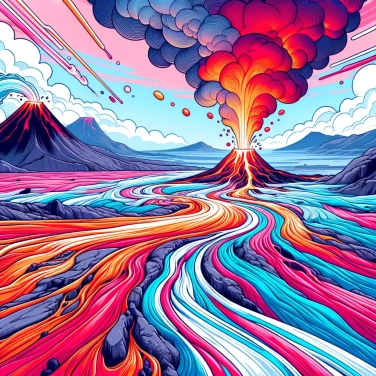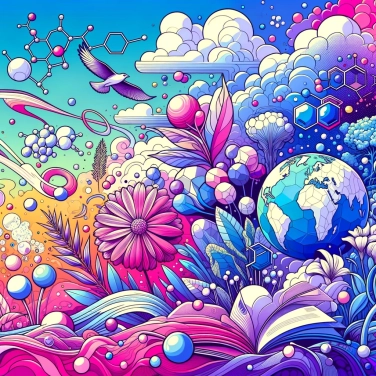The color of lava changes from white to red due to its temperature. When it is very hot, it emits a white light, then as it cools down, it takes on a reddish-orange hue due to the presence of oxidized minerals.

Very hot lava starts with a white or bright yellow color, as its temperature often exceeds 1000 to 1200°C. At these high temperatures, the molten rocks emit a tremendous amount of energy in the form of intense light. As it cools, the lava goes through orange hues, then red, reflecting a gradual decrease in heat. The lower the temperature of the lava, the darker its hue becomes, eventually turning dark red and then almost black, when a solid crust begins to form and harden. This change in color directly follows the decrease in thermal energy released, meaning: it flows fast and hot, you have white-yellow; it flows slowly and cools, you transition to dark red.
The color of lava largely depends on the minerals and chemical elements it contains. Lava rich in silica, for example, tends to be lighter, leaning towards bright orange or yellow when it is very hot. In contrast, those that are high in iron and magnesium display darker shades once cooled, leaning towards deep red or even brown-black. Certain minerals like olivine or pyroxene also influence the final color, sometimes giving a greenish or brownish tint to the cooled rock observed after the eruption. In short, tell me what your lava contains, and I'll tell you what color it is likely to glow when molten!
When lava cools very quickly, its temperature drops suddenly. As a result, its color rapidly changes from a bright white-yellow to an orange-red hue, and then quickly to a dark red. This is because color is directly related to the temperature of the material. By cooling abruptly, the lava quickly loses thermal energy and the atoms vibrate less. The less energy they have, the dimmer light they emit, leaning towards dark red. This rapid variation often explains why near the surface or in contact with water, lava shines much less brightly and quickly loses its fiery appearance.
The presence of mineral impurities (iron, sulfur, magnesium...) slightly changes the hue of the lava, sometimes giving it a darker or rustier appearance at the same temperature. The more iron a lava contains, the more it tends towards dark red or brownish shades during gradual cooling. Atmospheric pressure also affects the observed color: at low pressure, volcanic gases escape quickly, and the lava becomes dull and matte very quickly as it cools. Conversely, higher pressure can extend the bright and vivid color of hot lava for a longer time. In other words, impurities and pressure influence the transition from dazzling white to this darker red typical of cooled volcanic flows.
The cooled lava can form different types of rock depending on its cooling and composition: basalt, rhyolite, or andesite; each having unique characteristics that are utilized in construction or as decorative materials.
Although lava is often depicted as bright red in popular culture, when it reaches its highest temperature (above 1100°C), it becomes white and can even appear almost blinding to the naked eye.
The visible color of lava is sometimes used to quickly estimate its approximate temperature, which assists scientists and volcanologists in studying active volcanoes.
Volcanic glass, or obsidian, is created by the ultra-rapid cooling of lava. This material is so smooth and sharp that it was used by ancient civilizations to make arrowheads and cutting tools.
The main difference between lava and magma lies in their location: magma is found beneath the Earth's surface, in the mantle or the Earth's crust, whereas lava is magma that has reached the surface after a volcanic eruption. Once at the surface, magma changes its name and becomes lava.
The lava appears very bright at night because the light it emits strongly contrasts with the surrounding darkness. During the day, the intense brightness of the Sun significantly reduces this contrast, giving the lava a darker or less vivid appearance.
The color of lava is mainly an indicator of temperature. White or bright yellow lava is very hot, more fluid, and generally moves faster, posing a greater immediate danger. In contrast, dark red or orange lava is cooler, less fluid, and progresses more slowly, which usually allows more time to distance oneself from it. However, all lava remains extremely dangerous.
Under very specific conditions, yes. For example, lava can appear blue when blue flames associated with the combustion of sulfur gases escape near a volcano, such as on Kawah Ijen in Indonesia. As for a greenish hue, it may exceptionally come from mineral content rich in copper or other specific minerals, but this remains very rare.
The maximum temperature of lava primarily depends on its chemical composition, but it generally ranges between 700°C and 1200°C. Basaltic lavas, for example, can reach the highest temperatures, around 1100–1200°C, while rhyolitic lavas are cooler, ranging from 700 to 900°C.

0% of respondents passed this quiz completely!
Question 1/5